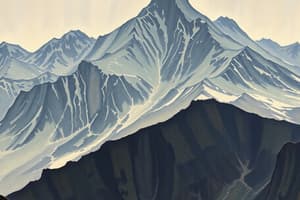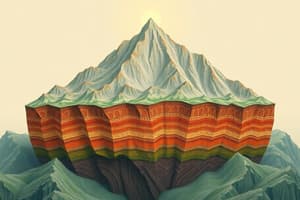Podcast
Questions and Answers
What are the four main layers of the Earth?
What are the four main layers of the Earth?
- Crust, Mantle, Inner Core, Outer Core (correct)
- Crust, Magma, Outer Core, Inner Core
- Crust, Mantle, Outer Core, Inner Core
- Crust, Mantle, Lithosphere, Asthenosphere
What specifically causes the movement of tectonic plates?
What specifically causes the movement of tectonic plates?
- Gravitational pull
- Convection currents (correct)
- Surface erosion
- Magnetic fields
Which of the following describes a fault?
Which of the following describes a fault?
- A crack in the Earth’s crust resulting from plate movement (correct)
- A solid structure within the Earth's layers
- The area where mantle meets the crust
- A type of igneous rock formation
What is the primary difference between weather and climate?
What is the primary difference between weather and climate?
In comparing inland and coastal climates, which statement is true?
In comparing inland and coastal climates, which statement is true?
What do contour lines on a topographic map indicate?
What do contour lines on a topographic map indicate?
Which of the following is NOT a factor for immigration to Canada?
Which of the following is NOT a factor for immigration to Canada?
What is a contour interval?
What is a contour interval?
Flashcards
What are the three main types of rocks?
What are the three main types of rocks?
The three main types of rocks are igneous, sedimentary, and metamorphic. Igneous rocks form from the cooling and solidification of magma or lava. Sedimentary rocks form from the accumulation and cementation of sediments. Metamorphic rocks form when existing rocks are transformed by heat, pressure, or chemical reactions.
What is plate tectonic theory?
What is plate tectonic theory?
The Earth's crust is divided into large, moving plates called tectonic plates. These plates float on the molten rock in the Earth's mantle. The movement of these plates causes earthquakes, volcanoes, and mountain formation.
What is a plate boundary?
What is a plate boundary?
A boundary is where two tectonic plates meet. There are three types of plate boundaries: convergent, divergent, and transform. At convergent boundaries, plates collide. At divergent boundaries, plates move apart. At transform boundaries, plates slide past each other.
What is a fault?
What is a fault?
Signup and view all the flashcards
What are weather and climate?
What are weather and climate?
Signup and view all the flashcards
What are contour lines?
What are contour lines?
Signup and view all the flashcards
What is a contour interval?
What is a contour interval?
Signup and view all the flashcards
What's the rock cycle?
What's the rock cycle?
Signup and view all the flashcards
Study Notes
Earth's Layers and Plate Tectonics
- Earth's layers include the Crust, Mantle, Inner Core, and Outer Core.
- Plate Tectonic Theory: Earth's surface is made up of plates that float on the molten mantle, moving in various directions.
- Plate Boundary: The point where two plates meet, where significant geological activity occurs.
- Fault: A crack in the Earth's crust, causing movement between plates.
- Plate Movement: Driven by convection currents within the mantle.
- Types of Rocks: Igneous, sedimentary, and metamorphic.
- Rock Changes: Driven by forces like melting, cooling, weathering, erosion, compaction, cementation, heat, and pressure.
- Rock Cycle: A continuous process where rocks change from one type to another through these forces.
Weather and Climate
- Weather: Daily combination of temperature, precipitation, cloud cover, and wind.
- Climate: Long-term pattern of weather in a specific region.
- Inland vs. Coastal Climates: Inland climates have greater temperature variations (hotter summers, colder winters), while coastal climates are more stable.
- Convectional Precipitation: Rainfall produced by convection currents.
Geographical Factors and Terms
- Geological Eras: Cenozoic, Mesozoic, Paleozoic, Precambrian.
- Soil Layers/Horizons: Organic matter, topsoil, subsoil, and rock particles.
- Compass Rose Degrees and Directions: Cardinal points (N, E, S, W) and ordinal directions.
- Contour Lines: Lines on a topographic map indicating elevation.
- Contour Interval: Vertical distance between contour lines.
- Latitude: Position of a location on earth measured in degrees north or south from the equator
- Ocean Currents , Winds and Air Masses, Elevations, Relief, Near water: Factors that influence climate.
Population and Resources
- Population Pyramids: Visual representations of population structure (age and sex).
- Types of Population Pyramids: Show different population growth (youthful, ageing, slow growth, rapid growth, zero growth, negative growth).
- Climate Change: Environmental changes caused by human activity.
- Carbon Footprint: The total amount of greenhouse gases generated in producing or using something.
- Oak Ridge Moraine: A valuable natural resource that should be protected (more information needed)
Studying That Suits You
Use AI to generate personalized quizzes and flashcards to suit your learning preferences.




